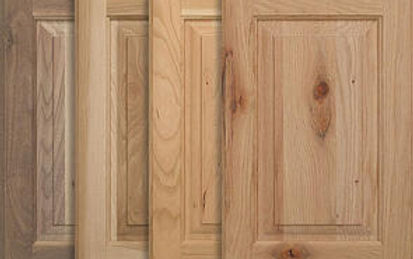Cabinet Door Wood Species and Materials
How to Choose the Right Cabinet Door
The look of your new kitchen will be heavily influenced by the type of cabinet door species you choose.
Assuming you don’t want any unwelcome surprises when your new cabinets arrive, it is important to understand the inherent colors and variations of each wood species and material available, and how those characteristics should shape your expectations regarding the appearance of your cabinetry.


Cherry
Cherry displays a distinctive grain pattern and warm color shadings, ranging from nearly white to dark reddish brown.
Dark pockets, pin knots, and random streaks are common. More than most woods, Cherry will darken (or mellow) when exposed to light, especially in light stains.
Its darker hues bring touches of warmth and elegance to any kitchen.

Maple
Maple is a durable, versatile hardwood with a fine, smooth grain that can be straight, wavy, or curly. It varies in color from nearly white to a slightly reddish brown. Mineral or sugar streaks occur naturally in Maple and can vary from piece to piece, which is more noticeable in lighter stains.
With the right finish, Maple can resemble more expensive hardwoods like Cherry.

Hickory
Hickory is a heavy, strong hardwood known for flowing, vibrant grain patterns and dramatic color variation. It can also exhibit random pecks, burls, and mineral streaks, with colors ranging across a wide spectrum, from nearly white to almost black.
These extreme variations can either be toned down by darker stains or displayed prominently in more rustic settings by using lighter stains.

Alder
Alder is a soft hardwood with a fine, straight grain and even texture. Color is light brown with a yellow or reddish tinge. When you compare alder's heartwood with its sapwood, there is insignificant color difference. Alder does not evolve in color or darken when exposed to light or heat as other wood do. Alder takes stains and finishes well. It is one of the softest hardwoods so it can be damaged easily. . Graining differences as well as normal color change can be expected.

Quarter-Sawn Oak
Quarter-Sawn Oak produces a linear grain pattern with rays and flecks that give it unique character and dimension.
In addition to a desirable grain pattern, quarter-sawn wood species are extremely stable and resistant to cupping due to their method of milling.
It is generally more expensive than its flat-sawn counterpart because it is more labor intensive to produce.

Flat-Sawn Oak
Oak is a strong hardwood with a coarse, linear grain that varies from straight to sweeping arch patterns.
Oak, at times, has small pinholes and tight knots. Its coloration can range from a golden blond to deeper tones.
This timeless choice blends with a wide array of design styles.

Birch
Birch is a smooth hardwood with straight, wavy, or curly grains.
While mostly a cream to light yellow color, the wood from the center of the tree has a darker reddish-brown hue, which may result in unique color variations.
It accepts all types of stains well and can help you achieve many different looks, from casual to refined.

Walnut
Walnut is a strong, stable American hardwood that ranges in color from creamy white to a medium purplish-brown.
Walnut cabinetry will have both flowing grain and straight grain. This combination is best showcased when it is finished in a natural stain.
It takes all stains well, however, making it a favorite choice for furniture grade cabinetry.

Lyptus
Grown in environmentally-friendly plantations in Brazil, Lyptus is a fine-grained hardwood with a rich, warm tone and striking color variations.
It is offered in dark finishes to neutralize the base color of the wood, giving it a rich look similar to Cherry. Lyptus darkens dramatically with exposure to light and compares favorably with Cherry in both durability and cost.

Rustic Woods
Cherry, Maple, Hickory, Birch, and Alder labeled as rustic will likely have character spots (knots, burls, blemishes, etc.) on the center panels, and they may also be on the stiles and rails of the cabinet doors and drawer heads, which could impact hardware placement.
Knots, if they appear, will be sound and will be closed. At certain angles, light could be visible through the knots.

Wood Veneer
Veneered cabinets are an affordable alternative to solid wood.
Thin layers of wood (veneer) are glued together with the grain at right angles over a core of medium-density fiberboard (MDF), which reduces splitting and cracking.
It lacks the durability of solid hardwood but is quite strong. It features a continuous grain pattern many people prefer.

Thermofoil
Thermofoil cabinet fronts are made from a single piece of medium density fiberboard (MDF), covered with a flexible, vinyl-like material using heat and pressure.
The stability of MDF makes components highly resistant to warping. Thermofoil is durable, low maintenance, and won’t change color over time. It can mimic the look of painted wood or have glossy finishes and exotic patterns.

Melamine
Melamine is a pressure and heat-fused laminate surface. It is applied over a single-piece of medium density fiberboard (MDF) to provide a dimensionally stable, easy-to-clean, moisture-resistant surface that will not promote the growth of bacteria.
It is available in both solid colors and beautiful textured patterns, typically for use in modern and contemporary designs.

UltraLux
Available exclusively from Ultracraft Cabinetry, Ultralux cabinet fronts are made by laminating a sheet of Acrylic over a core of medium density fiberboard (MDF).
This process results in a deep, high-gloss luster perfect for modern and contemporary designs. Ultralux components are scratch-resistant, easily cleaned with a microfiber cloth, and their MDF core makes them highly resistant to warping.
